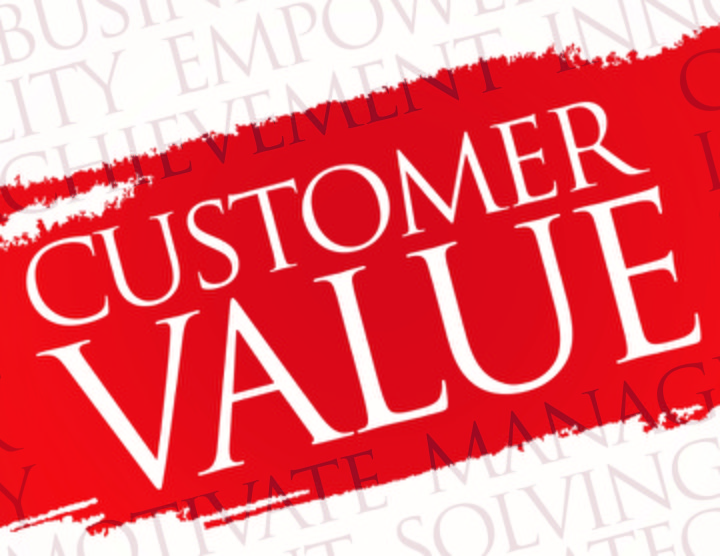In the first post of this series, we learned that buyers avoid talking to salespeople as long as they can, because most of them provide too little value and waste too much of their time. While we will address both sides of that equation in the next few posts, the first and most critical task is to provide value.
Lean communication starts—and ends—with value because if you don’t have something useful to say, it does not matter how concise or clear you are. The same idea clearly applies to selling: if you’re a salesperson, you must be useful to the customer—or they are totally justified in avoiding the sight or sound of you.
Years ago, when I used to train the business sales reps for a wireless carrier, we would role-play sales calls, in which the rep would spend the first few minutes telling me all their great features and what they could do for me, and I would usually counter each one by telling them their competitor could do the same thing. Usually, they would then say something like, “You get me in the deal.” I would then ask, “So What?” Rarely did I hear a convincing answer to that question.
If the customer asks you what value you add to their decision process, would you be able to answer the question convincingly? It’s tough, but if you pay attention to these five ways of generating and communicating customer value, you probably won’t even get the question:
Focus first on the why: You need to boost the why/what ratio in your sales conversations. Salespeople typically focus too much on the what, which is what they want the customer to do, what they want them to buy, what their product does, etc. They don’t spend enough time on the why, which is why the customer needs to make a change, why this is the best choice for them to make that change, and why now. By focusing first on the why, both parties can unpack the necessary elements of value so that they can then figure out the best what. (If this is starting to sound like an Abbott and Costello routine, I apologize.)
That’s why your plan for every sales call should begin, not with your call purpose, (which is what you hope to get from the call) but the value proposition for that particular meeting. Why should the prospect or customer take time out of their life that day to listen to what you have to say?
If you want to be even stricter, ask yourself honestly if the customer would pay to meet with you. It’s probably not to find out about the latest bell or whistle you’ve added to the product, or to check out the new white paper your marketing folks wrote. The only reason a customer would conceivably meet with you is if you have a plausible case that you—and only you—can improve their outcomes in some way.
One more hint: if you can’t think of the value the customer will receive in return for their time—don’t go.
Improve outcomes: This is a detailed and more specific look at the why. To focus on the right outcomes, you research, analyze, and question these four possible areas that might indicate a need:
- Problems: Known issues that are bothering them and/or costing money.
- Opportunities: Improvements in products, technologies, or ways of doing things
- Changes: Ongoing or imminent changes in their current environment they will have to adapt to
- Risks: Anything that could potentially hurt them or prevent the outcomes they want
Answer the question: the main question is “What do you want me to do and why should I do it?”, which is covered in the first two points above. But ATQ also applies when the buyer asks you a question. The whole reason they are talking to you is because despite all that reading of stuff on websites, they still have questions. And when they do have a question, they want someone to answer it honestly, completely, and quickly. The salesperson who is the most responsive in answering their questions will add the most value.
Outside-in thinking: We naturally view the world from the inside-out. We have our own thoughts, desires, needs and aspirations, and we view the world through the lens of how we can get what we want through other people. Outside-in thinking flips that around. It’s about seeing the world through the eyes of the customer, and then working backward to figure out how they can get what they want through us. OIT means that you talk far more about the customer than you do about yourself.
Preserving the relationship: Lean communicators value relationships as much as the next person, but they perhaps define the foundation of relationships differently. It is less about liking that it is about trust. Lean communication is not about “schmoozing” and telling great jokes. Of course relationships are important in sales, but the best relationships are nurtured by the salesperson’s sincere and transparent desire to put the customer’s needs first. If you follow the first four practices, the relationships will take care of themselves, even in those occasional situations when you tell the customer something they might not want to hear. You know the old saying, “Friends don’t let friends (fill in the blank)”, sometimes a relationship calls for one party to say something that the other person does not want to hear. This does not always make for the most amicable or pleasant relationship, but in the long run it’s what builds the most trust and the greatest value.
If you focus first on communicating value, your customers will gladly pay to have “you” as an added feature in every sale!
Other posts in this series:
Lean Communication for Sales: Talk Less, Sell More?
Lean Communication for Sales: Top-Down Communication
I’ve written almost 40 articles about lean communication, and hundreds of articles about sales, but this is the first time I’ve written about lean communication as it applies to sales. Is it possible that talking less can help you sell more?
To better answer that question, let’s first look at what buyers need, and then consider how well salespeople are meeting that need.
The principal purpose of a buying process is to produce an effective decision at the lowest possible cost, and that requires a lot of information, some of which is readily available on online and some which can only come from talking to a sales rep. But buyers would prefer not to talk to salespeople if they can help it. By now it’s a well-known fact that buyers are up to 60% of the way through their decision process before they contact a salesperson, according to the CEB.
Why do buyers avoid talking to salespeople as long as they can? According to The Challenger Sale, “…the celebrated ‘solution sales rep’ can be more of an annoyance than an asset.” In lean terms, that statement simply says that salespeople are seen as providing more waste than value.
The bigger and more complex the decision, the more information needed, and the more opportunity for waste in the process of acquiring it. At every step in the buying process, there is a tremendous amount of waste, including:
- Unclear understanding of their own needs
- Time and effort to uncover the information they need for a decision
- Differing internal perceptions of needs and priorities
- Effort to clarify ambiguity—much of it deliberate
- Incorrect information
- Delays in obtaining answers to their questions
- Information that is not tailored to their unique situation
- Sitting through 43-slide presentations to get the answer to one or two crucial questions
- Risk of making the wrong decision
And it’s not just buyers. Deep in their hearts, even though they would never say it, CEOs wish they could get rid of their sales forces. They cost a lot of money and they can be difficult to manage. Yet salespeople are not going away, despite all the predictions that the easy availability of information on the internet would make the sales profession wither away. That’s because they still serve a critical function: they provide information to help buyers make decisions—decisions that improve the buyers’ business and personal outcomes.
Salespeople are still needed because they add value, by communicating useful information that improves business and personal outcomes, while preserving the relationship. The first is essential, the second highly desirable. In the long run, it’s the product that delivers value to the customer, but it can’t do that until it’s chosen and implemented. And for that, it needs a salesperson.
But salespeople still have to do better. If they want to keep adding value in the final 40%, or—even better—get brought in sooner, lean communication can be a powerful asset. Look at it this way, if you are a buyer who has to undertake the time, effort and risk to make an important decision, how would you respond to a salesperson who:
- Has a sincere desire to create value
- Thinks and communicates from your side of the desk
- Is prepared to answer your most pressing questions, and does so candidly and completely
- Is transparent about their intentions
- Gives you only what you need when you need it to make the best decision
- Keeps things simple
- Does not waste your time
- Listens and actually responds to your concerns
- Lowers your cost and risk of making the best decision
I truly believe that lean communication and sales are a perfect match, and in the next five blog posts, I will show how each of the five principles of Lean Communication can significantly boost your results and your relationships: Value, Organization, Waste, Making Work Visible, and Pull.
Who knows, maybe you will be seen as more of an asset than an annoyance!
Other posts in this series:
Lean Communication for Sales: Value
Lean Communication for Sales: Top-Down Communication
Good salespeople are very confident of their skills and treasure their independence, so it’s natural that many of them resist the idea of planning. When I teach sales call planning, I often get these types of familiar objections from one or two participants in the workshop:
- I don’t need to plan because I’ve been doing this for years and I know what I’m doing.
- I don’t want to plan because it doesn’t let me be myself.
- I do plan, but I just don’t write it down.
- Plans are no good anyway, because the customer is always going to change things up on you.
What these objections boil down to is that salespeople think planning limits their creativity and flexibility. After all, a plan by definition imposes limits on what you can do, and sometimes you need the freedom to be creative and adapt to unplanned circumstances. These are legitimate concerns. Rather than addressing those objections myself, I’m going to bring in two experts—a comedian and a general, no less—who know a thing or two about structure and planning.
Planning can make you more creative
A sales call can often be a form of improv, because the unexpected always seems to pop up and you have to be creative in how you respond to it. That would seem to be a good reason not to have self-imposed limits in the form of a plan. But if you think you can be more creative without limits, let’s see what a truly creative person, comedian John Stewart, said about this:
People say, The Daily Show, you guys probably just sit around and make jokes. We’ve instituted—to be able to sort of weed through all this material and synthesize it, and try and come up with things to do—we have a very, kind of strict day that we have to adhere to. And by doing that, that allows us to process everything, and gives us the freedom to sort of improvise.
I’m a real believer that creativity comes from limits, not freedom. Freedom, I think you don’t know what to do with yourself. But when you have a structure, then you can improvise off it.[1]
I’m not a creativity expert, but I do believe you can’t be at your most creative unless you’re fully in the moment, and that’s what having a plan can do for you. Planning for your sales call frees up your mental resources to truly focus and listen to the customer. For example, I’ve found that writing out my questions beforehand lets me concentrate on what the customer is saying in answer to the one I just asked, and be more creative in my response, because I’m not half-thinking about what my follow-up is going to be.
Planning can make you more flexible
If you are one of those who pride themselves on being able to “wing it”, you should know that planning actually increases your flexibility to deviate when necessary—if you do it properly.
I’ve seen salespeople who take planning too far, using it as a straitjacket. They put so much effort into creating a perfect plan that they’re invested in it, and they stick to their plan or their prepared presentation no matter what the customer says or how they react. When they get a question or objection they haven’t planned for, they don’t know what to do. Or, they are so focused on the question they just asked, that they miss clear hints from the customer that there are other opportunities.
On the other hand, too much flexibility can also cost you. I once accompanied a senior executive from one of my clients on a sales call. Before the call, I asked to see his sales call plan, but the look he gave me made me immediately drop the subject. We met with the customer, the executive launched his “mental plan”, and after a couple of minutes the customer took control, focusing almost exclusively on price. My exec pal had maximum flexibility to respond, and that’s actually what happened. He won the business, but he also flexed himself into a rock-bottom, money-losing deal.
The anti-planners in my classes like to quote the old military dictum that, “No plan survives first contact with the enemy.” What they don’t realize is that the first person to utter that sentiment, if not the exact words[2] was my next expert: Helmuth von Moltke. Who is von Moltke? Glad you asked. He was the head of the Prussian General Staff who in the 19th century developed a system of planning that contributed mightily to the success of the German army for the next 80 years and forms an important basis of American military thinking today.
Von Moltke was trying to tackle the problem that Clausewitz called friction, which is a precursor and more sophisticated description of Murphy’s Law. Plans which are made in the quiet and distant contemplation of headquarters look great on paper, but they immediately run into difficulties, uncertainties, and unforeseen reactions from the adversary—who of course has a will and a plan of his own.
Recognizing the limits of the general’s knowledge, von Moltke didn’t throw out planning, but he did make it more flexible. He formulated the idea of what’s now called mission planning, or what management expert Stephen Bungay calls directed opportunism. He told his generals not to plan “beyond the circumstances that you can foresee”. What this meant in practice was being very clear about their intent, and leaving the details about what to do to the subordinates on the ground. The plan, as communicated to the person who has to carry it out, spells out what needs to be accomplished and why it’s important, and possibly some clear red lines which should not be crossed. The how is left up to the person on the spot who has a close-up, real-time view of the situation.
Since you plan and execute your own sales calls, what does this have to do with you? It might be useful to think of yourself as two different people[3]. Before the call, you are the commander forming the plan of battle. During the call, you are the subordinate on the spot who is tasked with completing the mission, i.e. achieving the commander’s intent. The general at HQ has some advantages. First, he has time to reflect, pull together additional information, figure out what resources he needs, anticipate how a line of questioning might go, etc. He also has emotional distance because he’s not under immediate pressure from the customer demanding an instant answer to a difficult question. The subordinate has the advantage of up-close and real-time access to information, and so being able to choose a reaction based on what feels right at the moment. Planning allows you to combine the best advantages of both people. It lets you figure out the main lines in advance, set some guidelines so you don’t get thrown off track, and then have the freedom to choose the appropriate response.
The result is not unlimited flexibility for its own sake, but intelligent flexibility, which is freedom within well-thought out limits. It’s intelligent because it gives you a more concrete basis to recognize when something is not going according to plan, and then to choose a response that that still aligns with your original intent, and it lets you find your way back to the main path when you’re forced to take a detour. It’s also intelligent because thinking carefully about the what and why is the surest way to connect your sales call purpose to the customer’s needs.
I began this article by stating the obvious point that many salespeople resist planning because it limits their freedom. If you define freedom as having unlimited options, that’s true, but that’s also a recipe for chaos and indecision. On the other hand, if you define freedom as the capacity to control your own results, it’s obvious that planning can set you free. As someone once said: “Liberty is the luxury of self-discipline.”
[1] From Dan Markovitz blog, 8/10/2015 http://www.markovitzconsulting.com/blog/
[2] What he actually said was, “No plan of operations can extend with any degree of certainty beyond the first encounter with the enemy’s main body.”
[3] Anyone who has woken up early on a cold morning to start that workout program they planned the night before, knows how common it is to feel like two different people.
Years ago, my wife and I planned a trip to Germany. I’m kind of a language dilettante, so I committed to learning as much German as I could so that I could get the most benefit from the experience. I studied a couple of beginning German books, and listened to cassette tapes (remember those?) during my daily commute. And it worked: I developed a decent repertoire of words and phrases and even had reasonably acceptable pronunciation, so I felt very confident when I got over there.
I almost immediately found out that the level of knowledge I had achieved was actually dangerous: it was good enough to get me into trouble but not good enough to get me out of it. When I would ask someone for directions, they would infer from my question that I spoke better German than I did, and would rattle off a list of directions. I could usually get the first sentence and maybe the second, but then I was totally lost after that—literally and figuratively. So, I would say thank you politely, head in the general direction they told me, and then try to figure it out from there. I soon stopped even trying to talk to people, because I was embarrassed to be found out. My wife, to this day, loves to make fun of the countless hours I wasted!
My shallow knowledge of German didn’t carry critical consequences besides embarrassment and a little confusion, but the consequences of shallow financial and business acumen for sales professionals can be very costly, to you, your company, and your customer.
It’s a commonplace in complex sales to say that salespeople should sell consultatively. Whether you call it challenger selling, insight selling, solution selling, or any other name you choose, it is the most effective way to succeed in the high stakes world of complex B2B sales.
But you can’t really be a consultant without a deep and nuanced understanding of your customer’s business. And if you try to challenge your customers, what happens when they challenge you back?[1] Some companies try to institutionalize this knowledge by creating “playbooks”, scripts and financial calculators that their salespeople can use to support their consultative approach. But what happens when the CFO or some other high-level executive, impressed with their approach so far, scratches beneath the surface and asks them a question they can’t answer?
At best, they may suffer a little embarrassment and loss of time as they admit they don’t know and offer to find out the answer. Of course, many salespeople don’t like to admit they don’t know, so they may try to bluff an answer, which generally ends badly, for the salesperson and for the client. Either way, they run the risk of foreclosing any future opportunity of getting on that person’s calendar again, and maybe even be shut out of the account entirely because the executive feels like he or she has been baited and switched. And if you’re the one who invested a lot of money and effort in the tool that does not get used because the salesperson feels burned by it, what are those costs?
I’m not against these tools. They are extremely useful and should be an integral part of your sales toolkit. But they should be introduced with a solid and deep foundation of fundamental business and financial acumen. At the very least, you need to know what the drivers are of their success, be able to compare their financial performance to their peers, be conversant in the key issues of their industry, and translate the impacts that your solution can deliver into their preferred financial measures and operational metrics. This doesn’t mean that you have to learn enough to go toe-to-toe with the CFO, but you should know enough to know to not only ask better questions, but to actually do something constructive with their answers, unlike a certain lost tourist!
[1] You probably won’t be able to do what Max Planck’s chauffeur did!






